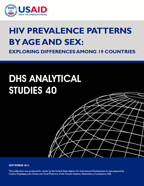- PUBLICATIONS
- JOURNAL ARTICLES
- ACCESS PUBLICATIONS
Publications Summary
- Document Type
- Analytical Studies
- Publication Topic(s)
- HIV/AIDS
- Country(s)
- Burkina Faso, Burundi, Cameroon, Congo Democratic Republic, Ethiopia, Ghana, Guinea, Kenya, Lesotho, Liberia, Malawi, Mali, Niger, Rwanda, Senegal, Sierra Leone, Eswatini, Zambia, Zimbabwe
- Language
- English
- Recommended Citation
- Gopalappa, Chaitra, John Stover, and Carel Pretorius. 2013. HIV Prevalence Patterns by Age and Sex: Exploring Differences Among 19 Countries. DHS Analytical Studies No. 40. Calverton, Maryland, USA: ICF International.
- Download Citation
- RIS format / Text format / Endnote format
- Publication Date
- September 2013
- Publication ID
- AS40
Download
 HIV Prevalence Patterns by Age and Sex: Exploring Differences among 19 Countries (PDF, 3530K)
HIV Prevalence Patterns by Age and Sex: Exploring Differences among 19 Countries (PDF, 3530K)
